Impact of Gas-to-Water Ratio on Treatment Efficiency of Submerged-Macrophyte Constructed Wetland Systems
Abstract
1. Introduction
2. Materials and Methods
2.1. System Construction
2.2. Determination of EPS Protein and Polysaccharide in Biofilm
2.3. High-Throughput Sequencing
2.4. Data Processing and Analysis
3. Results and Discussion
3.1. Effect of Different Gas-to-Water Ratios on Water Quality Treatment
3.2. Effects of Different Gas-to-Water Ratios on EPS
3.3. Alpha Diversity Analysis and Microbial Community Composition
3.4. Microbial Community Diversity
4. Conclusions
Author Contributions
Funding
Data Availability Statement
Acknowledgments
Conflicts of Interest
References
- Angeles-Núñez, J.G.; Cruz-Acosta, T. Aislamiento, caracterización molecular y evaluación de cepas fijadoras de nitrógeno en la promoción del crecimiento de frijol X1-Isolation, molecular characterization and evaluation of nitrogen-fixing strains in promoting the growth of beans. Rev. Mex. Cienc. Agrícolas 2015, 6, 929–942. [Google Scholar]
- Chen, H.; Zhang, S.; Lv, X.; Guo, S.; Ma, Y.; Han, B.; Hu, X. Interactions between suspended sediments and submerged macrophytes-epiphytic biofilms under water flow in shallow lakes. Water Res. 2022, 222, 118911. [Google Scholar] [CrossRef]
- Cheng, F.; Zhang, H.; Sun, S.; Li, Z. Cooperative denitrification in biocathodes under low carbon to nitrogen ratio conditions coupled with simultaneous degradation of ibuprofen in photoanodes. Bioresour. Technol. 2022, 351, 126988. [Google Scholar] [CrossRef] [PubMed]
- Fan, Y.; Sun, S.; He, S. Iron plaque formation and its effect on key elements cycling in constructed wetlands: Functions and outlooks. Water Res. 2023, 235, 119837. [Google Scholar] [CrossRef]
- Fu, F.; Huang, S.; Hu, H.; Lu, Y.; Wang, Y.; Yuan, J.; Gong, Z.; Wu, J.; Zhang, Y. Transformation of N and S pollutants and characterization of microbial communities in constructed wetlands with Vallisneria natans. J. Water Process Eng. 2021, 42, 102186. [Google Scholar] [CrossRef]
- Gonzalez-Gil, G.; Sougrat, R.; Behzad, A.R.; Lens, P.N.; Saikaly, P.E. Microbial Community Composition and Ultrastructure of Granules from a Full-Scale Anammox Reactor. Microb. Ecol. 2015, 70, 118–131. [Google Scholar] [CrossRef] [PubMed]
- Gu, P.; Wu, H.; Zhang, Z.; Li, Q.; Zhang, W.; Zheng, Z.; Yang, K.; Miao, H.; Xu, J. Biological effects of harvesting harmful algal blooms on submerged macrophytes and leaf biofilms: A mesocosm experiment. J. Clean. Prod. 2022, 361, 132256. [Google Scholar] [CrossRef]
- Han, S.-F.; Jin, W.; Qu, F.; Hanelt, D.; Abomohra, A. Integrated municipal wastewater treatment and lipid accumulation by a self-flocculating/floating microalga Limnothrix sp. Bioresour. Technol. 2024, 394, 130165. [Google Scholar] [CrossRef] [PubMed]
- Hussein, A. Textile Wastewater Treated by Constructed Wetlands–A Critical Review. J. Ecol. Eng. 2023, 24, 256–275. [Google Scholar] [CrossRef]
- Jiang, X.; Wang, M.; He, D.; Zhu, J.; Yang, S.; Fang, F.; Yang, L. Submerged macrophyte promoted nitrogen removal function of biofilms in constructed wetland. Sci. Total Environ. 2024, 914, 169666. [Google Scholar] [CrossRef]
- Kumar, S.; Sangwan, V.; Kumar, M.; Deswal, S. A survey on constructed wetland publications in the past three decades. Environ. Monit. Assess. 2023, 195, 992. [Google Scholar] [CrossRef] [PubMed]
- Li, Q.; Tian, X.; Gu, P.; Yang, G.; Deng, H.; Zhang, J.; Zheng, Z. Transcriptomic analysis reveals phytohormone and photosynthetic molecular mechanisms of a submerged macrophyte in response to microcystin-LR stress. Aquat. Toxicol. 2022, 245, 106119. [Google Scholar] [CrossRef] [PubMed]
- Li, T.; Cao, X.; Wu, Z.; Liu, J.; Hu, B.; Chen, H.; Li, B. Biotransformation of nitrogen and tetracycline by counter-diffusion biofilm system: Multiple metabolic pathways, mechanism, and slower resistance genes enrichment. Chem. Eng. J. 2023, 474, 145637. [Google Scholar] [CrossRef]
- Lin, Q.; Fan, M.; Peng, X.; Ma, J.; Zhang, Y.; Yu, F.; Wu, Z.; Liu, B. Response of Vallisneria natans to aluminum phytotoxicity and their synergistic effect on nitrogen, phosphorus change in sediments. J. Hazard. Mater. 2020, 400, 123167. [Google Scholar] [CrossRef] [PubMed]
- Liu, M.Z.; Hu, X.B.; Yan, J.; Mei, L.Y.; Li, X.T. Effects of intermittent aeration under different operation conditions on the pollutant removal of a pilot-scale constructed wetland. Fresenius Environ. Bull. 2019, 28, 1312–1318. [Google Scholar]
- Liu, Y.; Feng, B.; Yao, Y. Research Trends and Future Prospects of Constructed Wetland Treatment Technology in China. Water 2024, 16, 738. [Google Scholar] [CrossRef]
- Meng, F.; Lyu, Y.; Zhao, H.; Lyu, F.; Bie, X.; Lu, Y.; Zhao, M.; Chen, Y.; Lu, Z. LsrR-like protein responds to stress tolerance by regulating polysaccharide biosynthesis in Lactiplantibacillus plantarum. Int. J. Biol. Macromol. 2023, 225, 1193–1203. [Google Scholar] [CrossRef]
- Nájera, A.F.; Serwecińska, L.; Szklarek, S.; Mankiewicz-Boczek, J. Seasonal and spatial changes of N-transforming microbial communities in sequential sedimentation-biofiltration systems—Influence of system design and environmental conditions. Int. Biodeterior. Biodegrad. 2021, 159, 105203. [Google Scholar] [CrossRef]
- Ren, X.; Wang, Y.; Wan, J.; Yan, Z.; Ma, Y.; Zhang, G.; Zhu, B. The Nitrogen Removal Performance and Functional Bacteria in Heterotrophic Denitrification and Mixotrophic Denitrification Process. Water 2022, 14, 3603. [Google Scholar] [CrossRef]
- Seviour, R.J.; Mino, T.; Onuki, M. The microbiology of biological phosphorus removal in activated sludge systems. FEMS Microbiol. Rev. 2003, 27, 99–127. [Google Scholar] [CrossRef]
- Tian, J.; Han, Y.; Yin, P.; Zhang, J.; Guo, T.; Li, H.; Hou, Y.; Song, Y.; Guo, J. Response of dissimilatory perchlorate reducing granular sludge (DPR-GS) system to high-strength perchlorate and starvation stress in UASB reactor: Performance, kinetics and recovery mechanism. J. Environ. Chem. Eng. 2023, 11, 109414. [Google Scholar] [CrossRef]
- Tian, X.; Zhao, J.; Huang, J.; Chen, G.; Zhao, Y. The metabolic process of aerobic granular sludge treating piggery wastewater: Microbial community, denitrification genes and mathematical model calculation. J. Environ. Chem. Eng. 2021, 9, 105392. [Google Scholar] [CrossRef]
- Tomás-Martínez, S.; Zwolsman, E.J.; Merlier, F.; Pabst, M.; Lin, Y.; van Loosdrecht, M.C.; Weissbrodt, D.G. Turnover of the extracellular polymeric matrix of granules performing biological phosphate removal. Appl. Microbiol. Biotechnol. 2023, 107, 1997–2009. [Google Scholar] [CrossRef] [PubMed]
- Tsolcha, O.N.; Tekerlekopoulou, A.G.; Akratos, C.S.; Aggelis, G.; Genitsaris, S.; Moustaka-Gouni, M.; Vayenas, D.V. Agroindustrial Wastewater Treatment with Simultaneous Biodiesel Production in Attached Growth Systems Using a Mixed Microbial Culture. Water 2018, 10, 1693. [Google Scholar] [CrossRef]
- Wan, L.; Zhang, S.; Zhou, Z.; Chen, S. Plant Compartments Shape the Assembly and Network of Vallisneria natans-Associated Microorganisms. Diversity 2023, 15, 676. [Google Scholar] [CrossRef]
- Wang, C.; Sun, Q.; Wang, L.Y. Cadmium Toxicity and Phytochelatin Production in a Rooted-Submerged Macrophyte Vallisneria spiralis Exposed to Low Concentrations of Cadmium. Environ. Toxicol. 2009, 24, 271–278. [Google Scholar] [CrossRef] [PubMed]
- Wang, X.; Wu, Y.; Chen, N.; Piao, H.; Sun, D.; Ratnaweera, H.; Maletskyi, Z.; Bi, X. Characterization of Oxidation-Reduction Potential Variations in Biological Wastewater Treatment Processes: A Study from Mechanism to Application. Processes 2022, 10, 2607. [Google Scholar] [CrossRef]
- Wang, Z.; Zhang, Y.; Li, X.; Li, J.; Zhao, Z.; Hou, X. Mixed culture of plants improved nutrient removal in constructed wetlands: Response of microbes and root exudates. Environ. Sci. Pollut. Res. 2022, 30, 5861–5872. [Google Scholar] [CrossRef] [PubMed]
- Wu, C.; Zhou, L.; Zhou, C.; Zhou, Y.; Xia, S.; Rittmann, B.E. Co-removal of 2,4-dichlorophenol and nitrate using a palladized biofilm: Denitrification-promoted microbial mineralization following catalytic dechlorination. J. Hazard. Mater. 2022, 422, 126916. [Google Scholar] [CrossRef]
- Wu, M.; Hao, H.; Ge, Y.; Pu, T.; He, Z.; Ge, D.; Rene, E.R.; Huang, Z. Treatment of Black-Odorous Water Using Submerged Plants: The Physiological Response of Vallisneria natans. Water 2023, 15, 653. [Google Scholar] [CrossRef]
- Wu, W.; Yang, L.; Wang, J. Denitrification performance and microbial diversity in a packed-bed bioreactor using PCL as carbon source and biofilm carrier. Appl. Microbiol. Biotechnol. 2013, 97, 2725–2733. [Google Scholar] [CrossRef]
- Xiao, R.; Zheng, Y. Overview of microalgal extracellular polymeric substances (EPS) and their applications. Biotechnol. Adv. 2016, 34, 1225–1244. [Google Scholar] [CrossRef]
- Xing, W.; Li, J.; Li, P.; Wang, C.; Cao, Y.; Li, D.; Yang, Y.; Zhou, J.; Zuo, J. Effects of residual organics in municipal wastewater on hydrogenotrophic denitrifying microbial communities. J. Environ. Sci. 2018, 65, 262–270. [Google Scholar] [CrossRef]
- Xu, P.; Xiao, E.; Wu, J.; He, F.; Zhang, Y.; Wu, Z. Enhanced nitrate reduction in water by a combined bio-electrochemical system of microbial fuel cells and submerged aquatic plant Ceratophyllum demersum. J. Environ. Sci. 2019, 78, 338–351. [Google Scholar] [CrossRef]
- Yan, L.; Zhang, S.; Lin, D.; Guo, C.; Yan, L.; Wang, S.; He, Z. Nitrogen loading affects microbes, nitrifiers and denitrifiers attached to submerged macrophyte in constructed wetlands. Sci. Total Environ. 2018, 622–623, 121–126. [Google Scholar] [CrossRef]
- Yu, G.; Chen, H.; Chen, J.; Chen, S.; Long, Y.; Huang, J.; Wang, Y.; He, S. Enhanced nitrogen removal through aerobic denitrifying bacteria in horizontal subsurface flow constructed wetlands: Influencing factors and microbial community structure. Chem. Eng. J. 2024, 481, 148654. [Google Scholar] [CrossRef]
- Yue, F.; Zhang, F.; Qu, Q.; Wang, C.; Qin, Y.; Ma, L.; Jia, Y.; Ismael, M.; Jiang, Y.; Sun, T.; et al. Effects of ageing time on the properties of polysaccharide in tangerine peel and its bacterial community. Food Chem. 2023, 417, 135812. [Google Scholar] [CrossRef]
- Zhang, H.; Ge, Z.; Li, Y.; Huang, S.; Zhang, J.; Zheng, Z. Response of submerged macrophytes and leaf biofilms to different concentrations of oxytetracycline and sulfadiazine. Chemosphere 2022, 308, 136098. [Google Scholar] [CrossRef]
- Zhang, L.-J.; Xie, Y.; Ding, L.-Y.; Qiao, X.-J.; Tao, H.-C. Highly efficient ammonium removal through nitrogen assimilation by a hydrogen-oxidizing bacterium, Ideonella sp. TH17. Environ. Res. 2020, 191, 110059. [Google Scholar] [CrossRef]
- Zhang, L.; Huang, X.; Zhou, J.; Ju, F. Active predation, phylogenetic diversity, and global prevalence of myxobacteria in wastewater treatment plants. ISME J. 2023, 17, 671–681. [Google Scholar] [CrossRef]
- Zhao, D.; Chen, C.; Yang, J.; Zhou, S.; Du, J.; Zhang, M.; An, S. Mutual promotion of submerged macrophytes and biofilms on artificial macrophytes for nitrogen and COD removal improvement in eutrophic water. Environ. Pollut. 2021, 277, 116718. [Google Scholar] [CrossRef] [PubMed]
- Zhao, T.; Hu, H.; Chow, A.T.; Chen, P.; Wang, Y.; Xu, X.; Gong, Z.; Huang, S. Evaluation of organic matter and nitrogen removals, electricity generation and bacterial community responses in sediment microbial fuel cell coupled with Vallisneria natans. J. Environ. Chem. Eng. 2023, 11, 110058. [Google Scholar] [CrossRef]
- Zheng, S.; Liu, X.; Yang, X.; Zhou, H.; Fang, J.; Gong, S.; Yang, J.; Chen, J.; Lu, T.; Zeng, M.; et al. The nitrogen removal performance and microbial community on mixotrophic denitrification process. Bioresour. Technol. 2022, 363, 127901. [Google Scholar] [CrossRef] [PubMed]
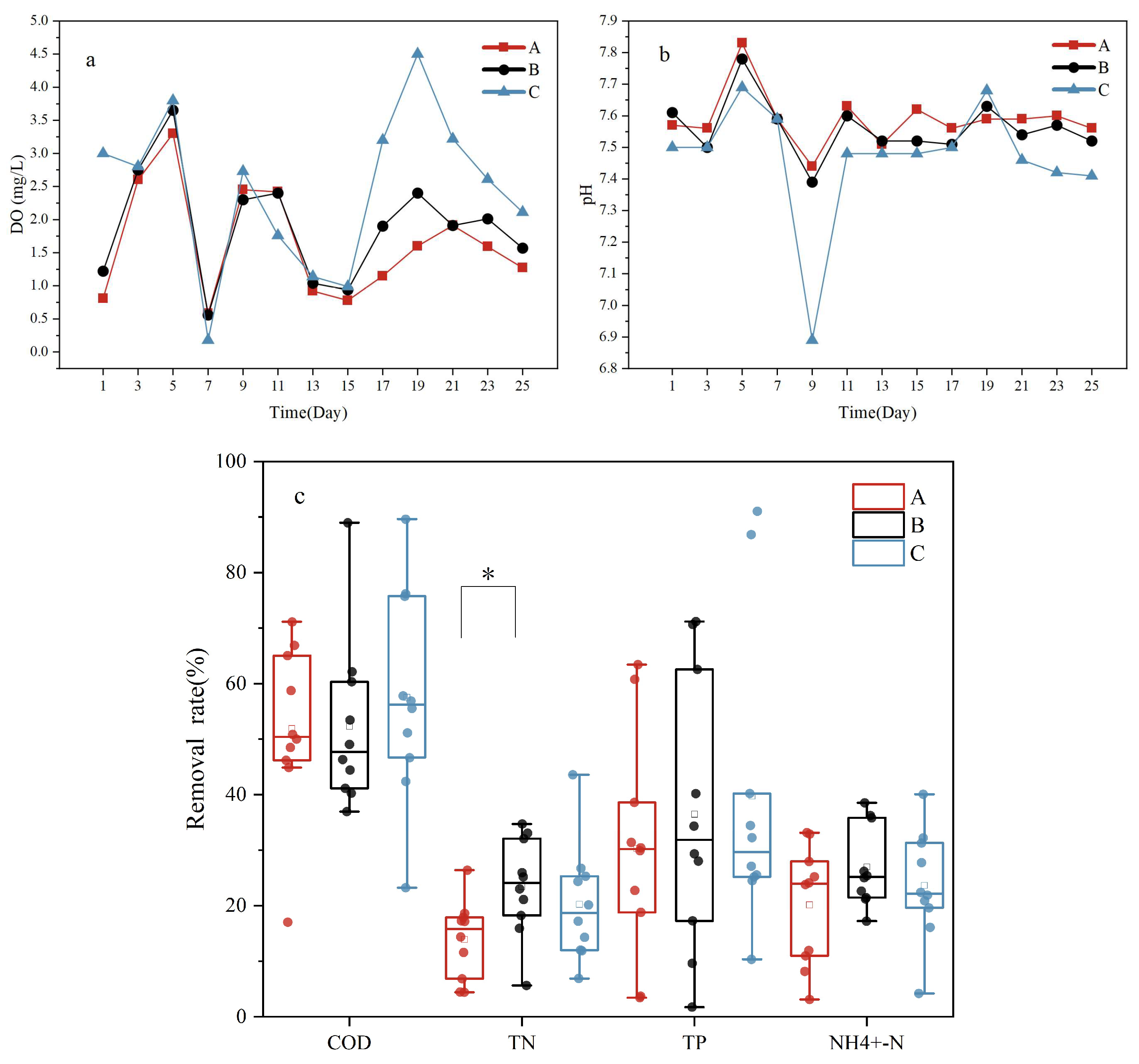
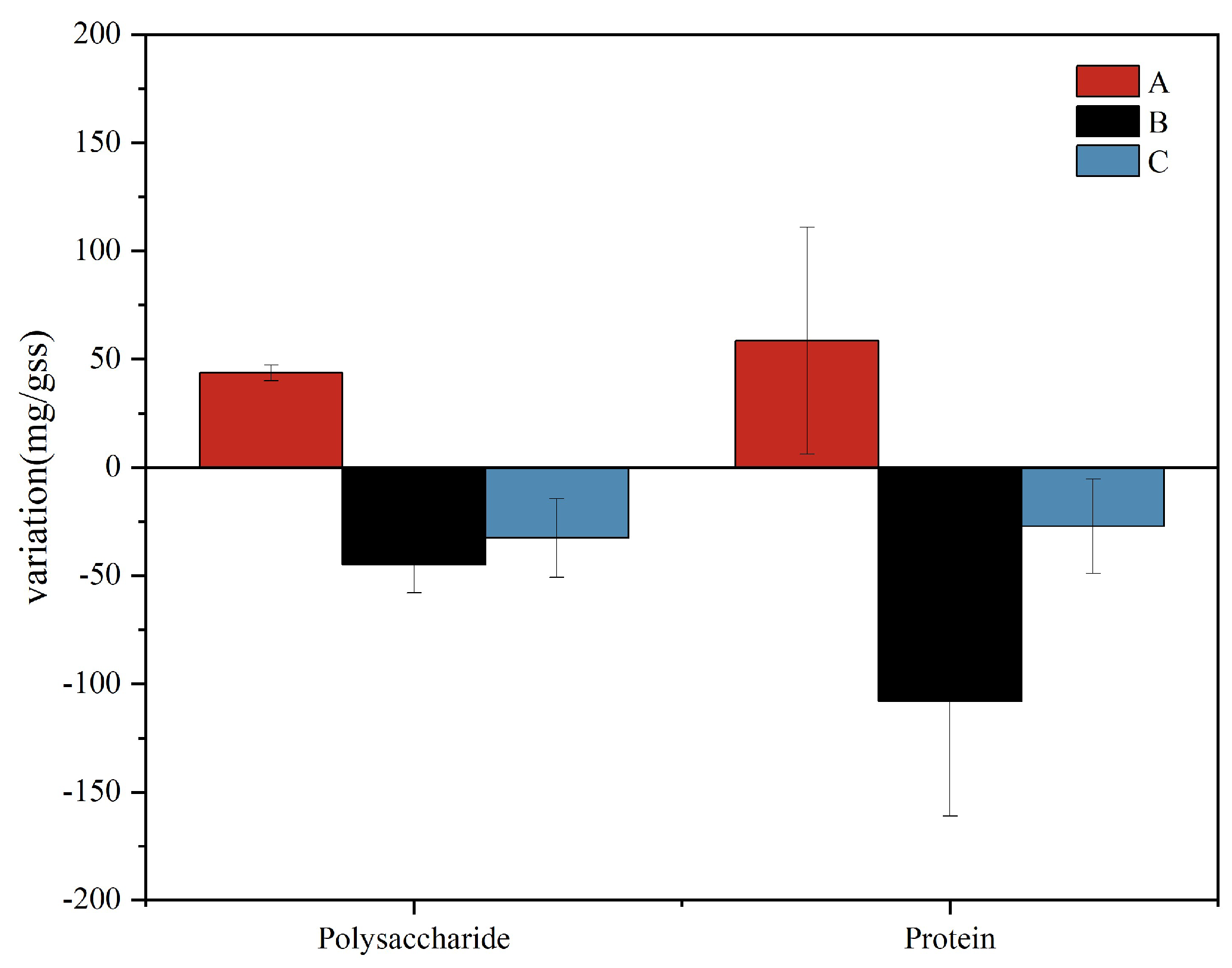
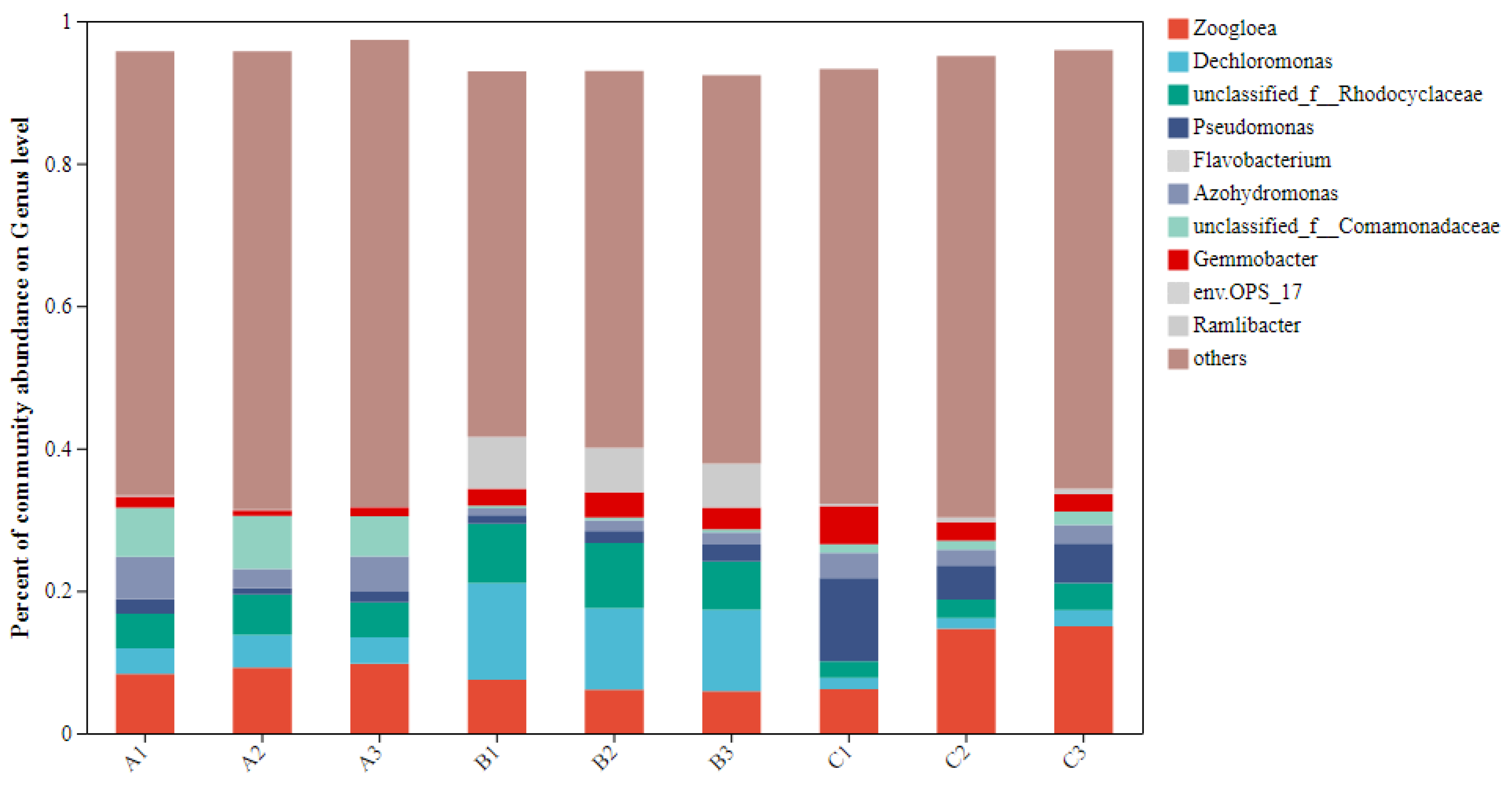
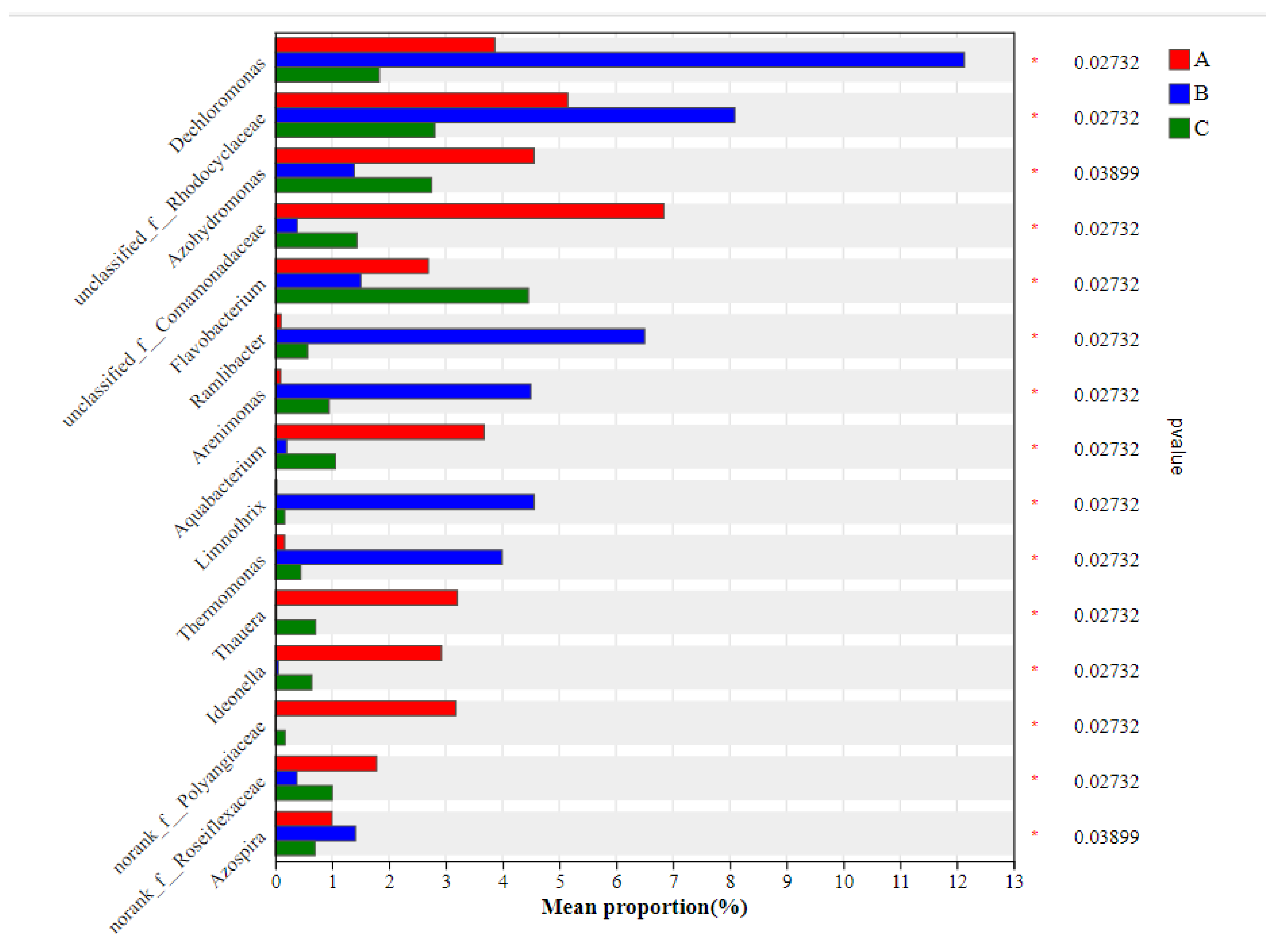
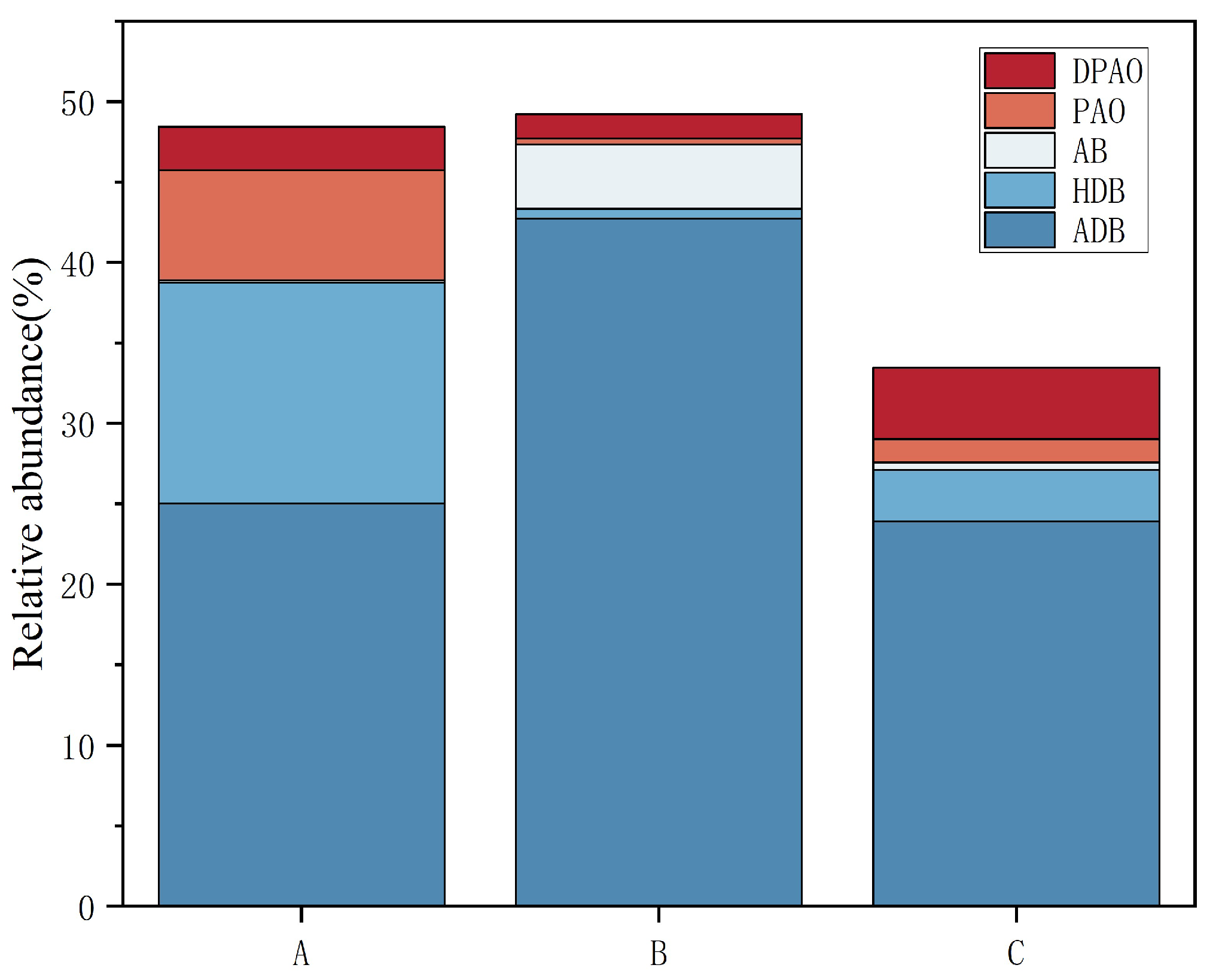
| Sample | Sobs * | Shannon * | Simpson | Ace * | Chao * | Coverage |
|---|---|---|---|---|---|---|
| A1 | 1037 | 5.28 | 0.013 | 1472.07 | 1508.50 | 0.9772 |
| A2 | 1017 | 5.30 | 0.012 | 1454.19 | 1472.63 | 0.9776 |
| A3 | 1073 | 5.29 | 0.013 | 1539.70 | 1525.28 | 0.9761 |
| B1 | 784 | 4.22 | 0.040 | 1781.48 | 1364.31 | 0.9772 |
| B2 | 779 | 4.28 | 0.040 | 1683.49 | 1287.37 | 0.9780 |
| B3 | 805 | 4.43 | 0.031 | 1661.36 | 1257.76 | 0.9782 |
| C1 | 1541 | 5.44 | 0.021 | 2130.90 | 2106.45 | 0.9661 |
| C2 | 1655 | 5.73 | 0.013 | 2393.24 | 2352.90 | 0.9612 |
| C3 | 1627 | 5.67 | 0.013 | 2415.20 | 2374.84 | 0.9604 |
Disclaimer/Publisher’s Note: The statements, opinions and data contained in all publications are solely those of the individual author(s) and contributor(s) and not of MDPI and/or the editor(s). MDPI and/or the editor(s) disclaim responsibility for any injury to people or property resulting from any ideas, methods, instructions or products referred to in the content. |
© 2024 by the authors. Licensee MDPI, Basel, Switzerland. This article is an open access article distributed under the terms and conditions of the Creative Commons Attribution (CC BY) license (https://creativecommons.org/licenses/by/4.0/).
Share and Cite
Mao, H.; Lu, S.; Huang, G.; Jia, X.; Bao, C.; Yan, X.; Zheng, X.; Zhao, M.; Jin, Z. Impact of Gas-to-Water Ratio on Treatment Efficiency of Submerged-Macrophyte Constructed Wetland Systems. Water 2024, 16, 1790. https://doi.org/10.3390/w16131790
Mao H, Lu S, Huang G, Jia X, Bao C, Yan X, Zheng X, Zhao M, Jin Z. Impact of Gas-to-Water Ratio on Treatment Efficiency of Submerged-Macrophyte Constructed Wetland Systems. Water. 2024; 16(13):1790. https://doi.org/10.3390/w16131790
Chicago/Turabian StyleMao, Hongming, Shiwen Lu, Guiying Huang, Xianle Jia, Chenqian Bao, Xinyi Yan, Xiangyong Zheng, Min Zhao, and Zhan Jin. 2024. "Impact of Gas-to-Water Ratio on Treatment Efficiency of Submerged-Macrophyte Constructed Wetland Systems" Water 16, no. 13: 1790. https://doi.org/10.3390/w16131790
APA StyleMao, H., Lu, S., Huang, G., Jia, X., Bao, C., Yan, X., Zheng, X., Zhao, M., & Jin, Z. (2024). Impact of Gas-to-Water Ratio on Treatment Efficiency of Submerged-Macrophyte Constructed Wetland Systems. Water, 16(13), 1790. https://doi.org/10.3390/w16131790






